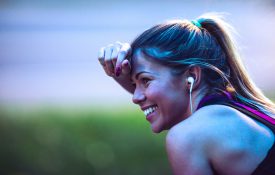-
New Research From Psychological Science
Read about the latest research published in Psychological Science: Bilingualism Modulates Infants' Selective Attention to the Mouth of a Talking Face Ferran Pons, Laura Bosch, and David J. Lewkowicz Children who grow up in a bilingual environment have the task of learning two languages rather than just one. What processes might help children during the dual-language acquisition process? Four-, 8-, and 12-month-old infants, either Spanish monolingual or Catalan monolingual (Experiment 1) or Spanish-Catalan bilingual (Experiment 2) watched a video of a woman speaking in their dominant native language or in a non-native language.
-
This is your brain on fencing: How certain sports may aid the aging brain
The Washington Post: The two fencers pull on their mesh-front masks and face each other behind two “en garde” lines. At their coach’s signal, they raise their sabres and the practice bout begins in a flurry. Michael DeManche, 69, is fencing his son Devin, 20, who not only has youth on his side but at 6-foot-5 also has a much longer reach. Father and son move rapidly, advancing, retreating and attacking with precision. The skirmish continues until the score is tied at four points. Then in a flash, Devin prevails with a swift hit on his dad’s mask. ...
-

A Sniff of Happiness: Chemicals in Sweat May Convey Positive Emotion
Humans may communicate positive emotions like happiness through the smell of our sweat. Visit Page
-
Mental Health for the Masses
The Huffington Post: Ricardo Muñoz thinks that MOOCs get a bad rap. MOOC stands for Massive Open Online Courses, Internet-based higher education available to anyone in the world, regardless of age or qualifications, and usually for free. MOOCs have become very popular in recent years, and now attract millions of students who want to learn art history or calculus or abnormal psychology with some of the world's best professors. Critics focus on MOOCs' dismal attrition rates. While millions of eager students may sign up, they say, most of these drop out. They point to examples, including one MIT MOOC, in which 155,000 enrolled but only 7,157 passed the course.
-
Leaders as Decision Architects
Harvard Business Review: All employees, from CEOs to frontline workers, commit preventable mistakes: We underestimate how long it will take to finish a task, overlook or ignore information that reveals a flaw in our planning, or fail to take advantage of company benefits that are in our best interests. It’s extraordinarily difficult to rewire the human brain to undo the patterns that lead to such mistakes. But there is another approach: Alter the environment in which decisions are made so that people are more likely to make choices that lead to good outcomes. ...
-
HIRING LESSONS FROM THE NEW ENGLAND PATRIOTS’ HEAD COACH
Fast Company: In the salary-cap era of football, which was meant to promote parity by forcing each team to spend the same amount of money, the Patriots have been an anomaly, building a dynasty that has won four Super Bowls in 14 seasons and 11 division championships in 12 years. What's the key to the team's success? It's simple: Bill Belichick's scouting and recruiting system. Year after year, the Patriots often forgo high-priced free agents for undrafted free agents and role players from other teams that step right into their system and perform at a high level. Take, for instance, Malcolm Butler, an undrafted free agent who became a Super Bowl hero.

